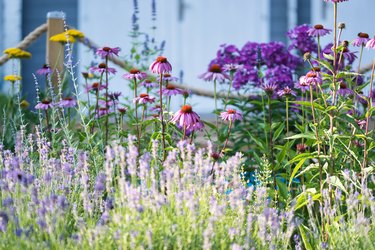
Plant photosynthesis involves the use of light, carbon dioxide, and water to manufacture energy. While soil helps to fortify plant structures and uptake nutrients, light is an essential component in producing actual food for the plant. When determining the effect of light on plant growth, there are three areas to consider: intensity, duration, and quality.
Intensity of Light
Video of the Day
Light intensity impacts many aspects of a plant's growth. Since it influences the manufacture of plant food, it also impacts the plant's stem length, leaf color, and flowering ability. Generally, if plants are grown in low light intensity, their branches will be spindly and their foliage a light green. Those in very bright light will be stronger with better branching structure, and their leaves will be larger and a darker green.
Video of the Day
The intensity of light available to a plant depends on both the strength of the light source at a particular time and the plant's exposure — that is, how close the plant is to the light source. The greater the distance between a plant and a light source — for example, a grow light — the lower the light intensity. Window exposure affects light intensity, with southern exposures having the most intense light and northern exposures having the least.
Duration of Exposure
Duration of light exposure means how many minutes or hours a day the plant is exposed to light. If the light source is not intense, increasing the duration of exposure can compensate, allowing the plant to manufacture enough energy to survive.
This will not work if the plant is one of those whose flowering cycle is sensitive to day length, like Christmas cactus. Don't overdo this, however. No plant should be exposed to light for more than 16 hours a day.
Quality of Exposure
The quality of a light source is also an important factor. Artificial light can be supplied with either incandescent or fluorescent lights. If this is the case, the quality of light or wavelength must be considered.
Light color represents the different energy frequencies contained within the visible light portion of the electromagnetic spectrum. The intensity varies depending on the type of color used as well as the wattage amount contained in a bulb. Red colors carry the lowest energy frequencies, while those toward the blue-violet end carry the highest frequencies.
Plants require mostly blue and red light for photosynthesis. However, infrared light is also needed for flowering. Fluorescent lights vary in light colors. Those with cool-white bulbs produce mostly blue light and are low in red light, and they work well for foliage plants. Blooming plants require extra infrared light supplied by incandescent lights or special horticultural fluorescent lights.